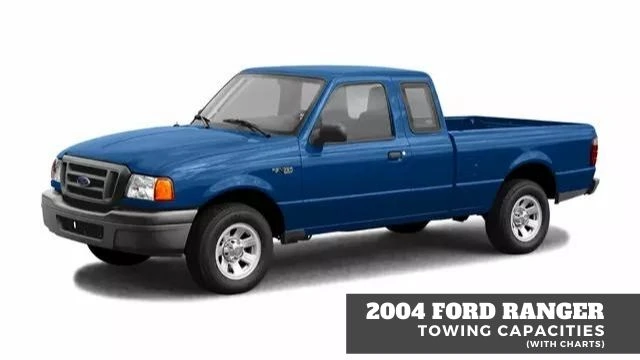The 2004 Ford Ranger had a lot of the exact same specifications when it came to towing capacity that we saw with other models that were made around the same time period and were able to attain a capacity rating of 5,980 pounds, which is impressive for such a small truck.
As remarkable as that appears to be though, there were similarly models that had a much more limited 1,520 pound max. capacity, which is a huge difference, so you need to study the chart and the data to know what models are the most capable.
Your owner's manual is packed with all sorts of useful info, and I highly suggest that you carefully review it and ensure that you observe all of Ford's requirements and suggestions.
2004 Ranger Overview
Overall Capacity: The overall towing capacity for the 2004 Ford Rangers ranged from 1,520-5,980 lbs. and like a lot of other Ford vehicles was dependent upon a few different variables. Some of these variables included the cab style, whether you had a 6-foot or 7 foot bed, if your truck was a two-wheel drive or four-wheel drive model, the engine it had equipped and the axle ratio that the truck used.
Capacity By Trim Options: There were five different trim levels available for the '04 Ranger and these are listed below with their respective names. In the brochure, it lists each trim level with the engine options that were available for each trim level, so with that data I was able to list the tow capacity range for each trim level.
- XL - 1,520-2,660 lbs.
- XLT - 1,520-5,980 lbs.
- FX4 - 3,100-5,980 lbs.
- Edge - 2,300-5,980 lbs.
- Tremor - 2,300-5,980 lbs.
It is important to note that some trim levels may be more limited than others due to limitations for that specific trim level. The chart below goes into a little more detail on what these are and how they affect the numbers.
By Engine Options: If we break down the data even further for these '04 Rangers and compare the three different engine options, we can see that the 4.0 liter engine was definitely the most capable and the 2.3 liter engine had the least amount of power out of the three options.
- 2.3L: 1,520-2,240 lbs.
- 3.0L: 2,300-2,660 lbs.
- 4.0L: 3,100-5,980 lbs.
The Tow Chart:
There was only one tow chart available for the 2004 Ford Rangers, but it was divided up into two separate charts. they consisted of automatic transmission models and manual transmission models. The automatic transmission models had a substantially higher-capacity overall when we compare the statistics to models that had the manual transmission equipped.
We do see the typical information that Ford usually showcases in their charts and this is the cab style that you had equipped on your truck, whether you had a two-wheel drive or four-wheel drive truck, what your bed length was and other metrics like the gross combined weight rating, axle ratio and the engine options that were available for these trucks.
There were also notes in this chart that do apply to certain trim levels, which typically have a lower capacity than what's listed for a specific trim level, so you will want to look at those in order to get an accurate figure.
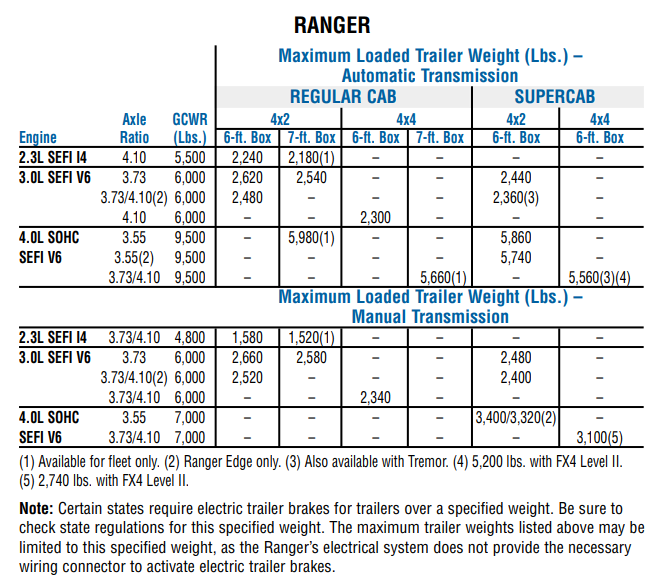

Other Important Information...
As I was evaluating the sources of information, I was able to find a couple more chunks of info that I thought was worth mentioning. The first screenshot that I have posted below outlines the standard tow package that was available for these trucks, along with the optional package that was also available. You can get a sense of what these packages included.
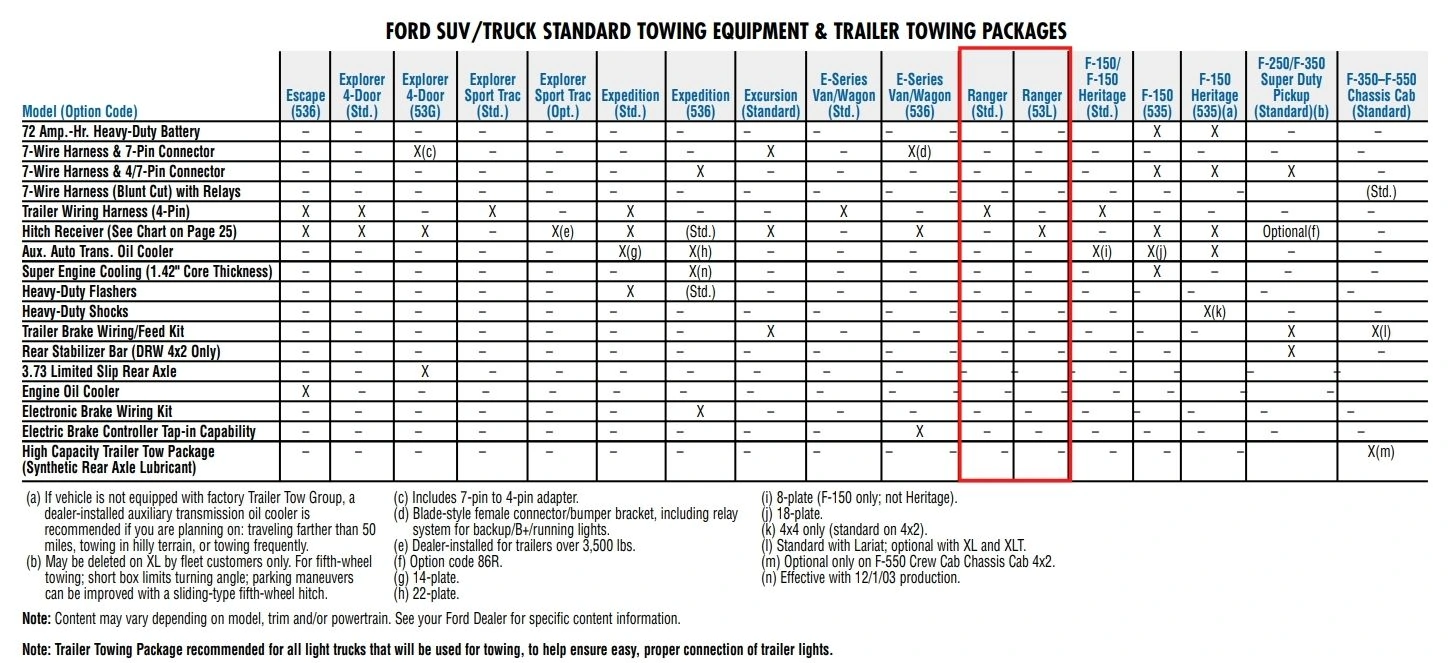
Moving on down the line, the second screenshot shows the hitch weight capacities for the different types of hitches, which in this case is a step bumper hitch and then a standard receiver hitch that most people will be using.
Even though the Ranger is capable of pulling up to 6,000 pounds, according to the chart below, you will have to have a weight distributing hitch in order to achieve these ratings, otherwise your capacity is significantly reduced to 3500, lbs.
If you're using a step bumper hitch instead of a standard receiver hitch, then that amount is reduced even further to 2,000 pounds.
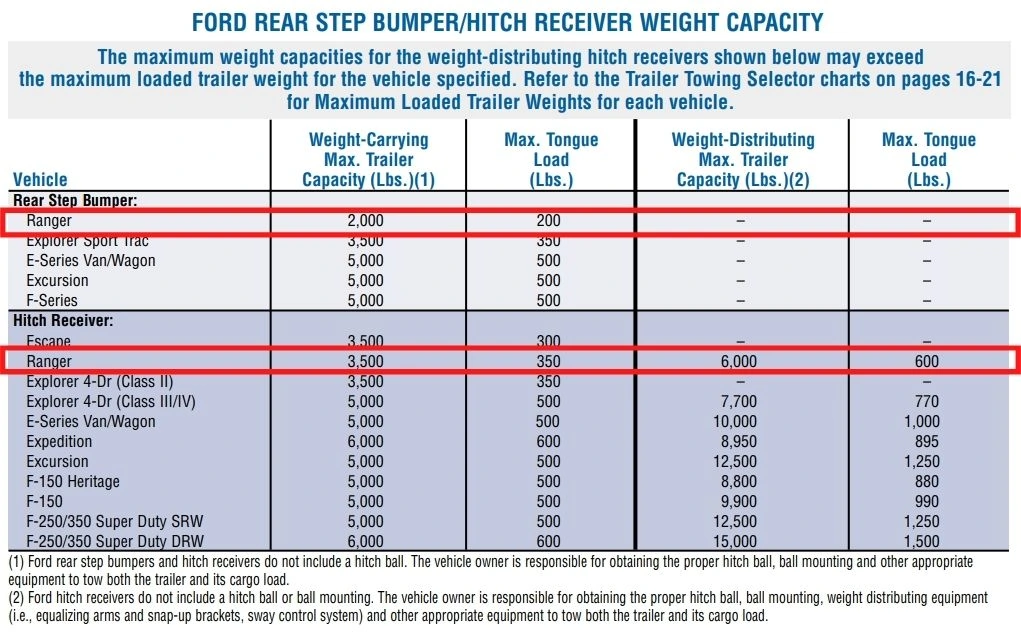
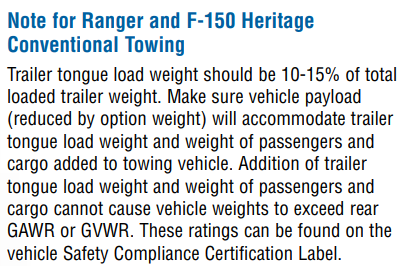
Tongue Weight

Trailer Brake Note
The Certification Label...
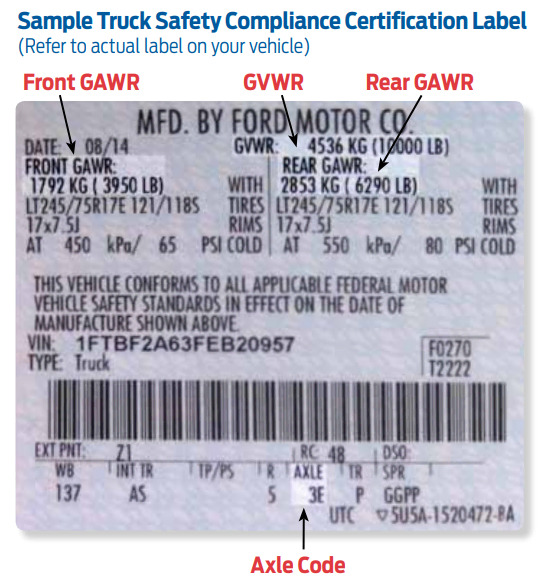
GVWR & GAWRs: The GVWR and GAWRs specifications were nowhere to be found when I was skimming through the owner's manual, however I did discover where we can find this data and it is actually found on the truck itself.
The certification tag is the label that you will want to identify on your vehicle, which can be found on your driver side door or door pillar and will mimic the sticker that I have displayed in the photo just above. Both GVWR and GAWR specifications can be located on the certification label, if you look towards the top of the sticker and will be displayed in both pounds and kilograms.
GCWR: What's helps out a lot is the fact that Ford gave us the gross combined weight rating specs in the tables, which can be located towards the left side of the table, right alongside the motor choices and axle ratios.
Axle Code: Another thing I wanted to point out on the certification label, is where you can find the axle code, which if you look at the image above is located towards the bottom of this label, towards the center.
You would typically take this code and decipher it in order to get the axle ratio you have equipped on your truck, but Ford did not list the chart that deciphers these codes in the 2004 guide, so you will have to use a third-party website or climb under your truck and look at your rear axle to see if you can find a metal stamped tag that has the axle ratio listed.
A Few Helpful Links:
Believe it or not, all of the info you see in this short article originated from two primary resources and I went ahead and linked to these references below.
The resource guide that Ford utilizes for each one of their vehicles proved to come in very helpful for this blog post and is where a lot of the related information originated from, consisting of a lot of the photos you see, however, the owner's manual is where I discovered all of the extra info that filled in the left over gaps.
Last updated on April 27th, 2022 at 07:25 pm
